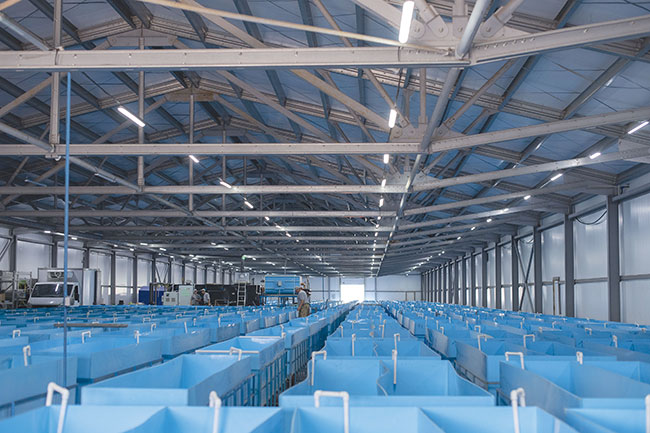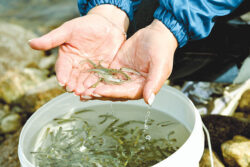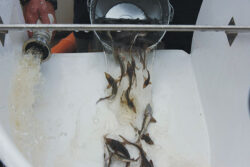
Features
Fish Nutrition
Russian hatchery gives a new shot to Soviet-era gas-to-protein feed
November 15, 2023 By Vladislav Vorotnikov
 main Photo: verKhorobin
main Photo: verKhorobin Sobskaya hatchery, one of the largest in Siberia, has kicked off an experiment of feeding muksun (Coregonus muksun) fry with gaprin, a protein derived from methane.
The preliminary results of the trials are promising, said Sobskaya, which is playing a vital role in the recreational programs in this part of Russia. As a part of regular fish feed, gaprin secures better gains, lower mortality, and bolsters immunity.
The technology is not brand new. In the 1970s, the Soviet Union tried to launch an industrial production of protein from hydrocarbons, building 12 plants across the country for the production of what was called bioprotein. Their combined performance was close to one million tonnes of either paprin, single-cell protein yeast grown on liquid paraffin medium; or gaprin, inactivated biomass of methane, oxidized bacteria, Methyllococcus capsulatus.
The problem, however, was that both technologies lacked sufficient studies confirming the efficiency and safety of the end products. Shortly after the beginning of the commercial use, farmers discovered that animals consuming paprin started to get sick.
“During several studies, meat from animals fed with paprin was found accumulating abnormal levels of amino acids, which were incorporated into nerve cells membrane, disrupting the processes of conducting a nerve impulse,” said Raisa Bashirova, senior researcher at Bashkiria State University. Moreover, paprin was found to be toxic for farm workers.
“The workers of the plants and local residents were developing diseases like thrush and bronchial asthma (after being in contact with paprin),” she added.
Not long after the problems were discovered, bioprotein production was curtailed, though gaprin was never found to be as hazardous as paprin. Several attempts to revive gaprin production have been made over the past few years, but with no tangible results, as gas-to-protein technologies remain one of the most controversial in the Russian feed industry.
In 2020, a Russian company, Metanica, started producing inactivated protein biomass of methane under the brand name, Metaprin, claiming it used a technology different from that utilized in paprin and gaprin production. The company explained Russia lacked from 1.5 million to 2 million tonnes of feed protein per year. Metaprin is primarily called to replace fishmeal in animal feed.
Here we go again
Russian scientists have edited the genome of bacteria converting methane in gaprin to make the technology more efficient, Sobskaya hatchery said, not providing additional details on this project.

Russian authorities hope new protein will help its recreational campaign.
Alexander Litvinenko, professor of the State Agrarian University of the Northern Trans-Urals, in charge of the project, disclosed that during the first week of the experiment, fish fry getting gaprin doubled its weight from 20 milligrams to 40 milligrams. The average yield was 40 per cent higher compared to the control group feeding on a regular diet.
“Protein from methane or natural gas was produced on an industrial scale back in the Soviet Union,” Litvinenko claimed, not saying anything about its safety. “In the 1990s, the plants were shut down, and the technologies were taken abroad. Now they are being restored.”
The success of the trials at the Sobskaya hatchery should breathe new life into gaprin technology, according to Litvinenko. Within a year, the first since the Soviet times, industrial gas-to-feed protein production is expected to be launched in the Tatarstan Republic in the central part of Russia. It is forecasted that several more plants will follow in the next years.
Sobskaya hatchery is not the first trying to use gaprin, Litvinenko disclosed. A group of Russian scientists have already tried to feed sturgeon (Acipenser) fry with this protein in the Tyumen region. The results of those trials were also encouraging. The average survival rate, usually limited to 55 per cent, jumped to as much as 90 per cent, while the average yields soared 50 per cent compared to the control group, Litvinenko reported.
Big Brother pays attention
The new attempt to revive gaprin production has already captured public attention in Russia.

Photo: Glavrybvod
The regional government of the Yamal-Nenets Autonomous Okrug reported it planned to have a closer look at the production technologies developed at the Sobskaya hatchery. The results of the experiment are likely to be included in a comprehensive programme aimed at restoring fish populations in the Siberian rivers. Among other things, this means the company will be eligible for an ample state aid.
Lyubov Okhman, deputy director of the agricultural department of the Yamal-Nenets Autonomous Okrug, expressed hopes that thanks to a better survival rate, the technology could help the authorities to restore the muksun and whitefish population in the Ob basin more effectively.
In 2023, Sobskaya hatchery plans to release 14 million units of fish fry to the regional lakes and rivers of the Yamal peninsula, Sergei Glukhov, chief fish farmer at the hatchery, reported. Since its launch in 2016, the hatchery has released 110 million units of fish fry. It is too early to say how the new technology could change production figures.
Print this page





